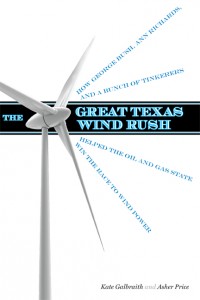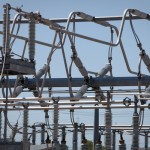How Texas Won the Race to Harness the Wind
 A Conversation with Kate Galbraith and Asher Price
A Conversation with Kate Galbraith and Asher Price
Texas is the oil and gas capitol of the country, with more rigs than any other state. With all that fossil fuel comes other industries, like refining and manufacturing, which also means Texas is the biggest polluter in the country. But in a surprising twist, the state has also become a leader in green energy: Texas has more wind energy than any other state, more than most countries even.
In their new book, ‘The Great Texas Wind Rush,’ reporters Kate Galbraith and Asher Price tell the story of how Texas became an unlikely leader in wind energy. It’s a story of dust bowls, “windcatters” and strange political and ideological bedfellows.
“I just thought it was incredible that the oil and gas state had become, in 2006, number one in wind energy, surpassing California of all places,” Galbraith, a former reporter for the Texas Tribune (a partner of StateImpact Texas), says of their inspiration to write the book. “Somehow they planted all these turbines in the Western Plains, and there it went!”
So how did Texas end up here, with over nine percent of its energy coming from wind last year?
Price, of the Austin American-Statesman, points out it was a long road. “In the 1970s, when our story really gets off the ground, the idea of alternative energy was really a hippie idea,” Price says. Visionaries like Michael Osborne looked out on the arid, windswept expanse and saw the potential for something more than brush and pumpjacks.
Osboune, a UT grad and acolyte of the legendary Armadillo music venue in Austin during the city’s Cosmic Cowboy era, had grown up in Pampa, which would eventually become ground zero for Texas wind energy. “He had a vision,” Price says. “Literally, he saw a comet streaking through the sky and thought there must be more to what he was doing and more to the energy landscape. So he went up to Pampa and planted one of the first wind turbines in the state.”
Those early years of “windcatting,” as the two describe it in their book, were full of trial and error. Lighting strikes, blade malfunctions, faulty designs. Osbourne “actually hired a couple of musicians, being an Armadillo type, to go up and fix them,” Galbraith says. “It’s fascinating how intertwined the music scene in Texas is with wind.” But in part thanks to their early efforts, wind eventually took hold in Texas.
Another factor that played into Texas becoming a wind leader were the state’s vast expanses of private property, with landowners willing to lease it out, as they had become accustomed to during earlier years of oil and gas drilling. “People that lived in these far-flung areas, they were often independent types, tinkerers, they knew how to work machinery,” Galbraith says. “And they were used to the idea of people coming, knocking on their door, and asking to create some energy. Usually, it was, ‘Let’s drill here,’ but in this new case it was wind power.”
But the catapulting moment for Texas wind came about in a way almost impossible to imagine now: Republican state leaders decided (in a rather progressive fashion) to make wind a real part of Texas energy. “The central irony of Texas wind power is, here you have a free-market minded red state that leads the nation in wind power,” Price explains. “And one of the reasons for that is because of a legislative mandate, almost a communist mandate, that ordered utility companies to get a certain amount of their energy from wind power.”
That mandate was known as the Renewable Portfolio Standard, signed into law by Governor George W. Bush in 1999, and extended by Governor Rick Perry in 2005, which caused rapid growth in wind energy. Those targets have since been been surpassed, and during the last legislative session, Galbraith points out, there was even an effort to repeal them.
In a similar vein, a huge, costly transmission line project to bring wind energy from the Panhandle to Central Texas is going to be paid for by spreading the cost out among Texas ratepayers, to the tune of roughly $260 for every Texan. (The overall cost of the project is currently estimated at $6.8 billion.) That project, approved just five years ago, seems like a hard sell in the fiscally-hawkish, free-market landscape of Texas politics today.
The same winds that had devastated the region in earlier years during the dust bowl are now producing clean energy, with zero emissions and zero water demands. But don’t hold your breath for anything similar to happen with solar in the state, the authors say.
“Going forward, you’re going to see a lot more pushback in terms of tax credits and subsidies for wind power,” Price says, and the same will apply to solar power. “I don’t see hope for it in the foreseeable future.” If Texas is going to get serious about solar, it likely won’t come with much help from the state.
Wind, meanwhile, still faces obstacles in Texas. Where it blows the most, in the Panhandle, it tends not to blow when the state needs it most: on hot, sunny summer afternoons as AC units are cranked up across the state. Technology to store wind energy to be used later, along with more wind development onshore in the Gulf Coast (where it blows at peak times), and even offshore, are the likely trends (and challenges) for Texas wind energy going forward, Galbraith and Price say. And in the Panhandle, where it all began, you could see more and more wind turbines in the future.
